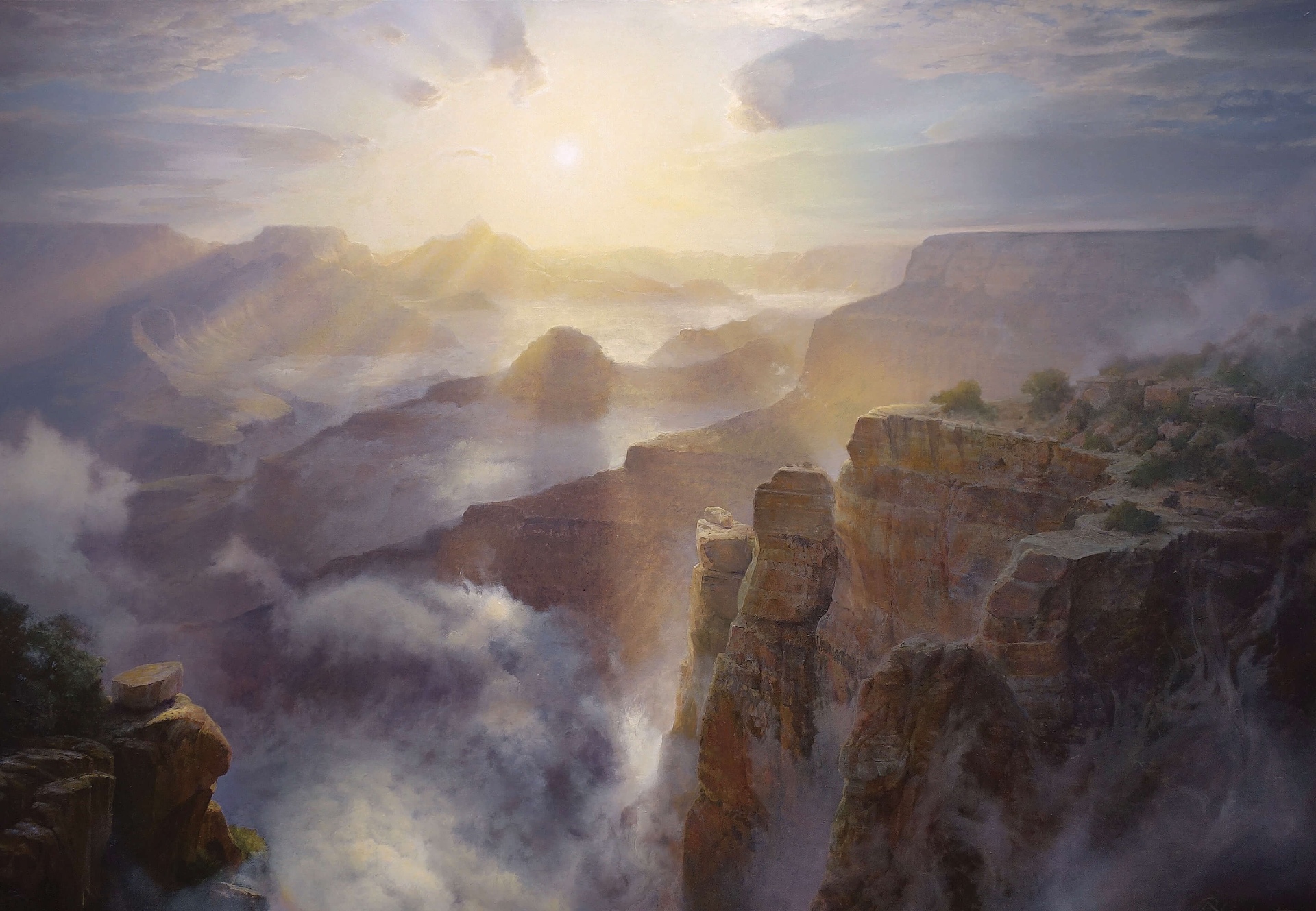
10 Mar Wild Blue Yonder
P.A. Nisbet, known to his friends as Peter or Pete, is also known as a cloud painter — not a common moniker for an artist. “If you look at art history, there’s not a lot of artists dedicated to atmospheric subject matter,” Nisbet says. “[John] Constable and [J.M.W.] Turner were masters at it, and it’s a neighborhood that I would be proud to be in.”
There’s evidence that Nisbet is already keeping good company, according to Mark Sublette, author and owner of Medicine Man Gallery in Tucson, Arizona. “Pete has always been steeped in the Old Masters, especially Thomas Cole,” says Sublette. “His unique way of painting in layers allows for a luminescence you rarely get with contemporary painters. He is a master of clouds and relates to their ephemeral nature, catching energy on canvas in a way few can do.”
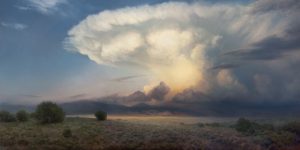
Sovereign Sky | Oil on Linen | 36 x 64 inches | 2012 | Photo Courtesy of Tucson Museum of Art
Nisbet was born in North Carolina in 1948 and began the study of painting at age 10. He graduated from the University of North Carolina and served as a U.S. Navy officer in Vietnam, before moving to the Southwest in 1980. Over the last 40 years, his sagacious works have earned many distinctions, including the 2020 Patron’s Choice Award at the Eiteljorg Museum’s Quest for the West show, where the artist has been recognized with six additional awards over the years. The Eiteljorg also honored Nisbet in 2017 with a retrospective titled Light, Space, and Power, an apt description for the sublime qualities of his paintings.
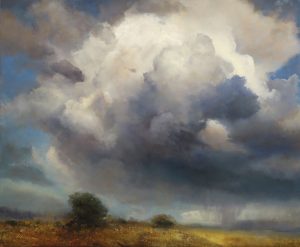
Storm at Pecos | Oil on Linen | 20 x 24 inches | 2021 | Photo Courtesy of the Meyer Gallery
Nisbet is not an artist who is quick to follow the newest trend. Nor is he a trendsetter. “I am the square peg in a round hole,” he says. “When I moved to the West, the statements I was making with my art were such that I didn’t know if it was going to work in the Western art market.”
But ultimately, being a square peg has only added to Nisbet’s career, according to Christine Brindza, senior curator at the Tucson Museum of Art (TMA). “Nisbet’s ability to paint like the Old Masters makes his work stand out among other artists of the present era,” says Brindza. “Perhaps, instead of being the square peg in a round hole, he is making a new hole entirely by reinterpreting old techniques with a modern-day perspective.”
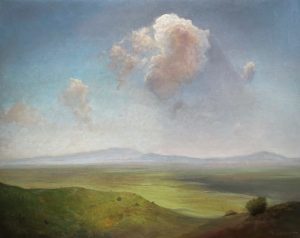
Cloud Dance | Oil on Linen | 16 x 20 inches | 2021
Nisbet credits artist Wilson Hurley, whom he greatly admired, for giving him a “thumbs up” when he needed one. A painter of clouds himself, upon seeing Nisbet’s 70-inch-wide oil painting of a thunderstorm at O’Briens Art Emporium in Scottsdale, Arizona in 1985, Hurley remarked, “Well look at that! Boy, you’re breathing down my neck.”
TMA’s acquisition of one of Nisbet’s paintings is an example of why his work is important today. “Nisbet’s Sovereign Sky painting in our collection combines historical romantic landscape traditions with contemporary conversations about Western environments,” Brindza says. “The painting is an essential link in the TMA collection that shows how works of art can help expand ideas for today’s audiences. It can transcend place and time.”
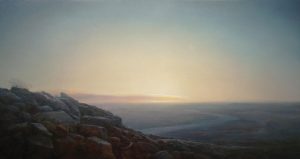
First Light | Oil on Linen | 32 x 60 inches | 2018 | Photo Courtesy of Medicine Man Gallery
Perhaps it’s precisely this transcendental quality that makes Nisbet an eminent painter. “Gallery patrons who discover Nisbet’s paintings are immediately arrested by his take on the landscape,” says John Manzari, owner of Meyer Gallery in Santa Fe, New Mexico. “They know they’re looking at something special, something more than the typical, ubiquitous landscape paintings found throughout the art world. He captures in paint a place the viewer may have visited before, either in stories, dreams, in person, or, perhaps, a place they yearn to discover.”
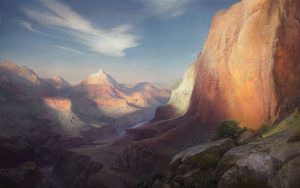
Below the Redwall | Oil on Linen | 30 x 48 inches | 2019 | Private Collection
Demystifying Nisbetís paintings requires understanding his approach to depicting clouds. “It takes me about two hours of plein air painting to capture a scene,” the artist explains. “Because the sun is tracking across the sky and the cast shadows are constantly changing, I try to freeze the sun’s movement by painting the shadows first, then I fill in the rest of the canvas.”
Back in his studio, these fresh impressions, backed up by photos, give Nisbet enough information to begin musing on what he might create. “I have no interest in creating accurate renderings as in a photograph,” he explains. “Much more important to me is ‘to dream into a place’ and then do sketches to quickly map it out. Once the ‘big idea’ is formed, I will commence a more formalized work, which may take me months to complete.”
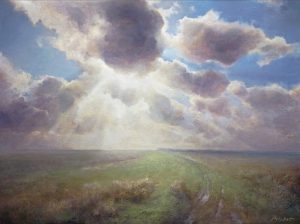
Light Storm, Cornwall | Oil on Linen | 18 x 24 inches | 2019 | Private Collection
Nisbet’s process also involves an intensive study of past masters. “In the case of 18th- and 19th-century paintings, the results are, more often than not, far better than anything I see today,” he says. “Contemporary work looks raw to my eyes, whereas those old paintings are much more tonally sophisticated; once you reduce their color schemes into black and white, you begin to see how well they utilized tonal gradations to render atmosphere and light. As far as I am concerned, it’s all about the light.”
One Old World technique that Nisbet utilizes is glazing — a method of applying layers of thin transparent sheets of paint, one over the other. These layers are like colored glass, interacting to create visual effects. Each layer must dry before the next layer is applied.
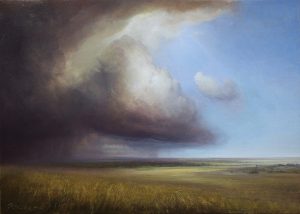
Thunder Comes Running, Little Bighorn | Oil on Canvas | 20 x 28 inches | 2018 | Photo Courtesy of Meyer Gallery
“Nisbet’s special quality of bridging the old with the new separates him from other landscape painters,” says Manzari. “In his approach, his landscapes are both classic and utterly contemporary. Art enthusiasts looking to add important work to their collections instantly recognize his mastery and thus the enduring quality of his work.”
Speaking about his subject matter, Nisbet explains, “The clouds I paint are not just about portraying forms that are beautiful. They are also exemplars of power, complexity, and the timeless dance of centuries past. There are differences today, however. The fires we see in the West spawn giant pyrocumulonimbus superstorms, smoky gray at the base and pearly white along the crowns. They can be terrifying — like the clouds that come out of volcanoes, tightly packed with solid particles swirling, producing lightning. They are undeniably important subjects for me to work with.”
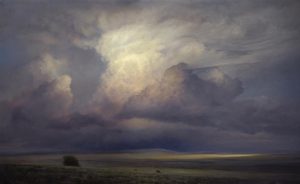
The Rites of August | Oil on Linen | 30 x 48 inches | 2021 | Photo Courtesy of Meyer Gallery
As for the future, Nisbet intends to keep chasing storms and painting. “I’m 73, and if all things go well, I might have a decade of painting left,” he says. “I am very concerned about bringing to my work the integrity of paintings I see in works from the 18th and 19th century. The old landscapists, such as Turner, got most of their concepts from journeys out of the studio while allowing for decades of formal study to lend a hand in giving birth to something hopefully exceptional. That’s the old method I love: an approach that preserves spontaneity. Maybe I am a throwback to another time. I’m comfortable being there.”






No Comments